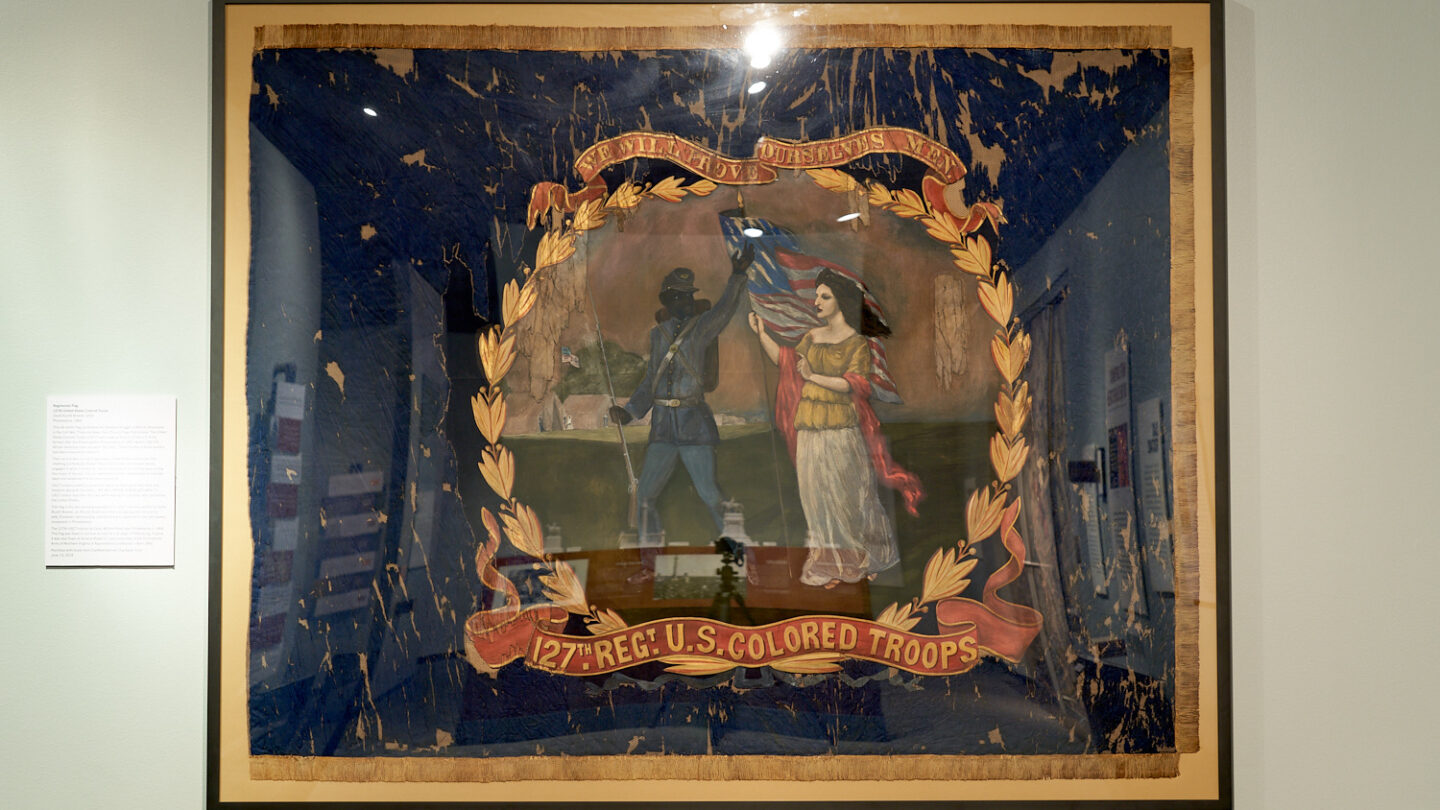
United States Colored Troops 127th Regimental Flag
While Atlanta History Center has 13 exhibition spaces for the interpretation of historic artifacts, the majority of the institution’s collection is cared for in storage. Altogether, the collection includes nearly 60,000 artifacts as well as 17,000 linear feet of manuscripts and archival items—that’s taller than sixteen Eiffel Towers!
Approximately 99% of those materials were donated by people of Atlanta. In this way, the collection tells personal stories of generations of Atlantans. When displayed together, they tell the greater story of our city as a whole.
Though we have tens of thousands of objects, we are actively expanding and diversifying our collection. Our city is made of many different cultures, ethnicities, and communities that live and work together. Atlanta History Center’s collecting strategy is designed to help communities across Atlanta preserve their history and allow for stories to be preserved and presented as part of the shared history of all Atlantans.
When we have the opportunity to add an object to our collection that helps to better tell the history of all Atlantans, we do our best to make it happen. We had the chance to do just that with our recent acquisition of the United States Colored Troops 127th Regimental Flag.
Atlanta History Center’s Archival Collections Storage
The Acquisition Process
You might think it’s a pretty simple process to donate your grandmother’s tea set to Atlanta History Center, but we have an involved, collaborative process for determining what is added to our collections. When an object is considered for acquisition, it is reviewed by Atlanta History Center’s Collections Committee, including staff curators, librarians, and archivists.
If the committee elects not to keep the object, they recommend other institutions that may be interested in adding it to their collection. (For example, we don’t collect silver, but the Charleston Museum is known for it. If someone brought in a silver collection, we may recommend them to our friends in Charleston.) If the committee agrees that we should keep the item, accession begins in earnest. The collections team photographs and documents the item, then enters it into our digital catalogue. At this point, the object is given a collections number—the secret code of museums.
Installation of the USCT 127th Regimental Flag in Atlanta History Center’s main atrium on July 3, 2019.
Every museum has their own way of determining collections numbers, but they all have the same core function of keeping track of all our stuff. For Atlanta History Center, we use the year it was given to us, the collection number, and each object’s number within that collection. For example, with collection management number 2019.33.M1, 2019 is the year we acquired the object, 33 stands for the 33rd collection acquired this year, and M1 signifies that it is a museum artifact and is the first (and only) object within the acquisition. A single accession can have one or many objects. Our Southern cookbook collection, for example, has thousands of publications.
Our Newest Accession
In June 2019, Atlanta History Center made an exciting addition to our collection: item 2019.33.M1, the United States Colored Troops 127th Regimental Flag. The flag’s accession is another conscious step in our ongoing and concerted effort to expand our Civil War collections to better represent the African American experience.
Purchased at auction on June 13, 2019, the flag is a unique and unusual addition. Firstly, it’s very rare for us to purchase items at all—especially one this costly. Second, the flag is itself a one-of-a-kind artifact. Of an estimated 300 flags used by African American regiments in the Civil War, fewer than 25 survive today.
Following the Militia Act of 1862, the United States Army accepted African American troops. They were formed into segregated regiments known as the United States Colored Troops (USCT). In 1862, approximately 1% of the Northern population was black. However, by 1865 nearly 12% of U.S. troops were African American. USCT soldiers fought and died in nearly every major campaign between 1863 and 1865. Their soldiers earned a combined 25 Medals of Honor. USCT regiments were the first U.S. troops to enter the defeated cities of Charleston and Richmond. President Abraham Lincoln cited the USCT as instrumental in the United States’ victory.
The USCT 127th Regimental Flag is painted on both sides. Here’s a peek at the reverse side.
The flag’s artist, David Bustill Bowser, painted 11 USCT battle flags. The one acquired by Atlanta History Center is the only one of his flags still in existence. Not only that, but we know the history of the regiment to which it belonged. The U.S. Army recruited its soldiers in Pennsylvania, New Jersey, Maryland, and Delaware. Some of the men were previously enslaved in Virginia and North Carolina.
In 1864, the men of the 127th regiment were sent to Virginia where they saw combat during the pivotal Siege of Petersburg. The regiment and the flag were present at Appomattox Court House when Robert E. Lee surrendered on April 9, 1865, effectively ending the Civil War.
Over the past 20 years, Atlanta History Center’s collection of USCT artifacts has steadily grown and includes a canteen, two swords, a rifle, brass drum, knapsack, Bible, veterans’ badge, a Medal of Honor, and more. These items, along with the regimental colors of the 127th regiment, are powerful touchstones to the African American Civil War experience.
As Atlanta History Center strives to tell a more complete story of the Civil War, we invite you to view the 127th USCT Regimental Flag, now on display in our main atrium. Because of the flag’s sensitivity to light, it will only be on view through July 24, 2019. The flag will be on display again in our exhibition Black Citizenship in the Age of Jim Crow, opening on January 18th.
Share Your Story!
Atlanta’s story is ongoing and ever-changing, and we are always seeking additions to our collections to reflect the vibrant and unique ways that Atlantans are making history. If you are interested in donating items, images, or documents, please reach out to us at collections@atlantahistorycenter.com or 404.814.4040.
